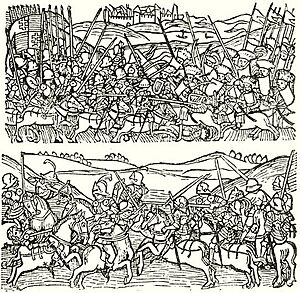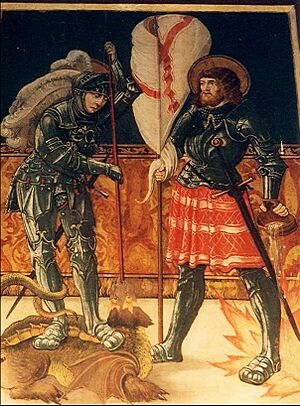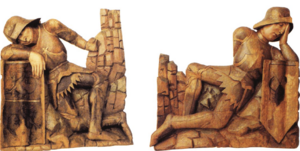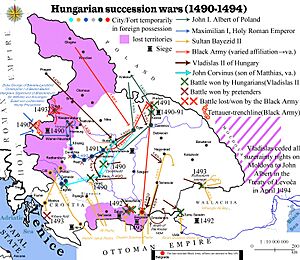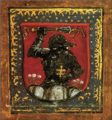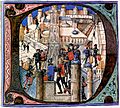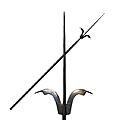Black Army of Hungary facts for kids
Quick facts for kids Black Army |
|
|---|---|
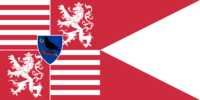
Standard of the Black legion
|
|
| Active | 1458–1494 AD |
| Country | Kingdom of Hungary |
| Allegiance | Hungarian, Czech (Bohemian, Moravian, Silesian), Polish, Croatian, Serbian, Wallachian, Bavarian, Austrian, Swiss |
| Branch | Army, navy |
| Type | Cavalry, infantry, artillery, siege weapons |
| Size | approx. 28,000 |
| Heraldry | This characteristic flag with a forked tail was reconstructed after a miniature in Philostratus Chronicle, one of the Corvinas, representing the 1485 entry of János Corvinus, son of King Matthias, into Vienna. In the Philostratus Chronicle, the apparent black colour of the flag used to be white (argent), but the argent paint oxidized. The reconstruction preserves the original colour. |
| Mascot(s) | Raven |
| Engagements | Holy Roman Empire, Bohemia, Poland, Serbia, Bosnia, Moldavia, Wallachia, Italy |
| Disbanded | 1494 (due to money shortage and mercenary uprising) |
| Commanders | |
| King | Matthias Corvinus |
| Notable commanders |
Pál Kinizsi, Balázs Magyar, Imre Zápolya, John Giskra, John Haugwitz, František Hag, Vuk Grgurević, Đorđe Branković |
The Black Army (also known as the Black Legion or Black Regiment) was a famous military force that served under King Matthias Corvinus of Hungary. This army existed from 1458 to 1494. It was one of the first professional armies in Europe.
Unlike most soldiers at the time, who were farmers or bakers for most of the year, the Black Army soldiers were full-time fighters. They were paid well and focused only on warfare. This made them very effective. They helped King Matthias conquer large parts of Austria, including its capital Vienna in 1485. They also won important battles against the Ottomans, like the Battle of Breadfield in 1479.
King Matthias understood that new weapons like firearms were important. About one in four soldiers in the Black Army had an arquebus (an early type of gun). This was a very high number for that time. The army mainly used infantry (foot soldiers), artillery (cannons), and both light and heavy cavalry (soldiers on horseback).
Contents
What Made the Black Army Special?
A Professional Fighting Force
The Black Army was different from other armies of its time. Most armies were made up of regular people who were called to fight only when needed. These soldiers usually had other jobs, like farming.
But the Black Army was a standing army. This means its soldiers were full-time professionals. They were paid regularly and trained constantly. This made them very skilled and ready for battle at any time.
How Big Was the Army?
When the Black Army first started, it had about 6,000 to 8,000 soldiers. By the 1480s, it grew to between 15,000 and 20,000 men. In 1485, during a big military parade in Vienna, the army reached its largest size with 28,000 soldiers. This included 20,000 horsemen and 8,000 foot soldiers.
This made the Black Army much larger than almost any other permanent army in Europe at that time. Its soldiers came from many different places, including Czechs, Germans, Serbs, Poles, and later, Hungarians.
Why Was it Called the Black Army?
There are a few ideas about how the Black Army got its name. Some people think it was called "black" because of the dark uniforms or flags they used.
Another idea is that the name came from one of their captains, "Black" John Haugwitz. His nickname was well-known, and people started calling the whole army "Black" because of him. The name became common after King Matthias died, when some unpaid soldiers caused trouble.
How the Army Was Organized and Paid
Changes in How Soldiers Were Recruited
In the early days of King Matthias's rule, armies were formed in old ways. Nobles had to provide soldiers based on the number of peasant families they owned. For example, a noble might have to send one archer for every 20 peasant households.
King Matthias changed these rules. He wanted a more professional army. He started hiring skilled soldiers from other countries, like Bohemia. These mercenaries were experienced fighters. This was a big change from the older system where nobles provided less trained soldiers.
How the Army Was Funded
As King Matthias's power and wealth grew, so did the size of his army. To pay for this large professional force, he needed a lot of money. He increased taxes on peasants and sometimes collected royal payments twice a year.
He also reformed the money system to make it easier to collect taxes and pay his soldiers. His yearly income was around 650,000 florins, which was a huge amount for the time. This money allowed him to maintain two large armies: the Black Army and another professional army guarding the southern borders against the Ottomans.
Branches of the Black Army
The Black Army had different types of soldiers, each with a special role.
Heavy Cavalry
Heavy cavalry were knights on horseback, wearing strong armor. They were the main attacking force in battles. They could charge the enemy and often decide the outcome of a fight. They usually made up about one-sixth of the army.
Their main weapon was the lance, a long spear used for charging. They also carried swords, maces, and axes for close combat.
Light Cavalry (Hussars)
King Matthias introduced the traditional hussars, who were light cavalry. They were faster and more flexible than heavy cavalry. Their job was to scout, protect the main army, cut enemy supply lines, and make surprise attacks.
Hussars were lightly armed, usually with a helmet, mail shirt, sabres, and spears. They also used bows and throwing axes.
Infantry (Foot Soldiers)
The infantry formed the stable base of the army. They included heavy infantry, shielded soldiers, light infantry, and soldiers with firearms. They often used large wooden shields called pavises. These shields could protect them from enemy attacks and create a movable "fortress" for archers and gunners.
The infantry used many different weapons:
- Melee weapons: Halberds (a pole weapon with an axe blade and a spear point), pikes (long spears), and swords.
- Archery: Crossbowmen were highly valued for their ability to shoot through armor.
- Arquebusiers: These were soldiers with early firearms called arquebuses. They were used at the start of battles. A unique Hungarian tactic was to rest their guns on top of their pavises for stability, instead of using a separate fork.
River Fleet
King Matthias also built a strong river fleet. This fleet was made up of wooden galleys and gunboats. They sailed on rivers like the Danube, Tisza, and Sava. The fleet was very important for controlling trade routes and helping in sieges, like the victory at Belgrade in 1456.
By 1479, the fleet had 360 vessels and could carry 10,000 soldiers. King Matthias even added artillery to these riverboats.
Challenges and the End of the Black Army
Soldier Rebellions (Mutinies)
One big challenge for the Black Army was keeping its soldiers paid on time. If they didn't get their money, soldiers sometimes left or even rebelled. These revolts were dangerous because the soldiers were highly skilled.
For example, in 1481, 300 horsemen left and joined the enemy. In 1465, a captain named Jan Švehla and his men left the army because they weren't paid. King Matthias had to fight against these former soldiers. He was very strict with rebels, sometimes ordering executions to set an example.
The Army's End
When King Matthias Corvinus died in 1490, the Black Army faced big problems. The new king, Vladislaus II, and the Hungarian nobles wanted to reduce taxes. This meant there wasn't enough money to pay the army.
Without regular pay, many Black Army soldiers started to loot villages to get money. Some even switched sides and joined enemy armies. Paul Kinizsi, one of Matthias's famous generals, was ordered to stop the plundering. In 1492, he defeated a group of Black Army soldiers who were causing trouble.
The Black Army was officially disbanded in 1492. The remaining soldiers were either integrated into local garrisons or left the country. The last group of Black Army mercenaries was defeated in Austria in 1493. In 1494, some frustrated soldiers in Belgrade even tried to betray their fort to the Ottomans, but their plan was stopped. The end of the Black Army weakened Hungary's defenses significantly.
Images for kids
-
Statue of King Matthias and his generals in Cluj-Napoca. From left to right: Pál Kinizsi, Balázs Magyar, King Matthias, István Szapolyai and Stephen Báthory.


